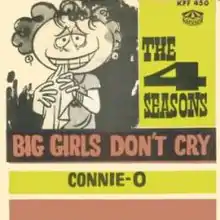| "Big Girls Don't Cry" | ||||
|---|---|---|---|---|
 | ||||
| Single by The Four Seasons | ||||
| from the album Sherry & 11 Others | ||||
| B-side | "Connie-O" (non-LP track later included on Golden Hits of the 4 Seasons album) | |||
| Released | October 1962[1] | |||
| Recorded | September 1962 | |||
| Studio | Universal Recording (Chicago)[2] | |||
| Genre | ||||
| Length | 2:26 | |||
| Label | Vee-Jay | |||
| Songwriter(s) | Bob Crewe, Bob Gaudio | |||
| Producer(s) | Bob Crewe | |||
| The Four Seasons singles chronology | ||||
| ||||
"Big Girls Don't Cry" is a song written by Bob Crewe and Bob Gaudio and originally recorded by the Four Seasons. It hit number one on the Billboard Hot 100 on November 17, 1962, and, like its predecessor "Sherry", spent five weeks in the top position but never ranked in the Billboard year-end charts of 1962 or 1963. The song also made it to number one, for three weeks, on Billboard's Rhythm and Blues survey.[6] It was also the quartet's second single to make it to number one on the US R&B charts.
Background
According to Gaudio, he was dozing off while watching the John Payne/Rhonda Fleming/Ronald Reagan movie Tennessee's Partner when he heard Payne's character slap Fleming in the face. After the slap, Fleming's character replied, "Big girls don't cry." Gaudio wrote the line on a scrap of paper, fell asleep, and wrote the song the next morning.[7][8] However, the line does not appear in that film. According to Bob Crewe, he was dozing off in his Manhattan home with the television on when he awoke to see Payne manhandling Fleming in Slightly Scarlet, a 1956 film noir based on a James M. Cain story. The line is heard in that film.
Like "Sherry", the lead in "Big Girls Don't Cry" is sung mostly in falsetto. With this song, the Four Seasons became the first rock-era act to hit the number one spot on the Hot 100 with their first two chart entries (their first single, "Bermuda"/"Spanish Lace", did not appear on any Billboard chart in 1961).
In 2015, "Big Girls Don't Cry" by The Four Seasons was inducted into the Grammy Hall of Fame.[9]
Personnel
Partial credits.[10]
- The Four Seasons
- Frankie Valli – lead vocals, handclaps
- Tommy DeVito – harmony and backing vocals, guitar, handclaps
- Nick Massi – harmony and backing vocals, bass, handclaps
- Bob Gaudio – harmony and backing vocals, piano, handclaps
- Additional musician and production staff
- Panama Francis – drums
- Bob Crewe – producer
- Bruce Swedien – engineer
Charts
Weekly charts
| Chart (1962–1963) | Peak position |
|---|---|
| New Zealand (Lever Hit Parade)[11] | 1 |
| UK Singles[12] | 13 |
| U.S. Billboard Hot 100[13] | 1 |
| U.S. Billboard R&B[14] | 1 |
All-time charts
| Chart (2018) | Position |
|---|---|
| US Billboard Hot 100[15] | 183 |
References
- ↑ Frankie Valli & The 4 Seasons (1991-11-19), Greatest Hits, Volume 1, Internet Archive, Warner Special Products, retrieved 2023-01-30
{{citation}}: CS1 maint: numeric names: authors list (link) - ↑ Cogan, Jim; Clark, William (2003). Temples of Sound: Inside the Great Recording Studios. San Francisco, California, USA: Chronicle Books. p. 133. ISBN 0-8118-3394-1.
- ↑ Dunbavan, Peter (28 February 2017). An Avid's Guide to Sixties Songwriters. AuthorHouse. ISBN 9781524633455.
- ↑ Guarisco, Donald A.. The Four Seasons – The Genuine Imitation Life Gazette: Review at AllMusic. Retrieved November 29, 2016.
- ↑ Marsh, Dave (2007). The Beatles' Second Album. Rodale Books. ISBN 9781594864261. Retrieved 7 October 2022.
- ↑ Whitburn, Joel (2004). Top R&B/Hip-Hop Singles: 1942–2004. Record Research. p. 212.
- ↑ Joe Sasfy, liner notes (1987). "The Rock 'N' Roll Era". Frankie Valli & the Four Seasons. Time-Life Records.
- ↑ "Jersey Boys Playbill", with discussion of history of hits
{{cite web}}: CS1 maint: postscript (link) - ↑ "GRAMMY HALL OF FAME AWARD". www.grammy.com. Retrieved 2023-07-18.
- ↑ "Panama Francis - DRUMMERWORLD".
- ↑ Flavour of New Zealand, 17 January 1963
- ↑ Roberts, David (2006). British Hit Singles & Albums (19th ed.). London: Guinness World Records Limited. p. 210. ISBN 1-904994-10-5.
- ↑ Joel Whitburn's Top Pop Singles 1955–1990 - ISBN 0-89820-089-X
- ↑ Whitburn, Joel (2004). Top R&B/Hip-Hop Singles: 1942–2004. Record Research. p. 212.
- ↑ "Billboard Hot 100 60th Anniversary Interactive Chart". Billboard. Retrieved January 14, 2019.